

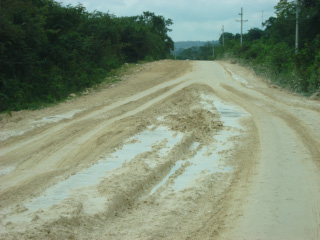
Chapter 4. Guatemala
(Bert) Judy, ever wishful of finding a Pheasant Cuckoo, asks me, “Is that the cuckoo calling?” In the midst of preparing for our departure, I stop to listen to the bird. “No, that’s a tinamou.” In fact, it is the single “whoop” note of a Thicket Tinamou, one I would not expected to hear at our San Ignacio campground.
(Shari) Fog so thick it is wet. Ground is holding more water than last night. Fears of getting stuck abound. We are afraid Lee will get stuck trying to reach the dump site so he has to wait until the next available camping site to dump. Moral: grab it when you can, you never know what is down the pike. Superwoman Judy whimps out and lets Mark drive her truck to pull Gilford’s truck and 5th-wheel out of the soft ground. We take the first four out the gate and wait on the roadside. I think Ralph and Dorothy get stuck too but finally we are all on the road.



(Bert) It seems like it takes forever for us to get all 12 rigs out of the muddy campsite and lined up beside the Western Highway. In convoy, we head the short six miles to the Guatemala border. Exiting Belize is three steps – I will call them Hurdles 1 to 3 - and it goes fairly smoothly except for trying to keep the group together. It’s a bit like herding chickens, with some not coming when called, some wandering off in the wrong direction, some being left behind, all of them clucking questions simultaneously.
(Shari) I have been dreading this border crossing and feel a little sick. We planned it and told everyone our procedure: I am to walk from the lineup of RV’s from front to back, Arleen is to walk from the back forward, collecting passports and we are to meet in the middle. Meanwhile Bob is to drive to position number 2 to help Bert do the paperwork. Everyone is to lock their vehicles and follow us into the buildings. I walk back but no Arleen. By the time I get to the end of the line, there is no Bob in the driver’s seat. I walk forward again, since I do not know how long he will be. I go in to the building and start processing the passports, handing the agent the men first in rig order then the women. Unfortunately, the officer wants to have each person present with their passport and not everyone is here yet. The plan goes awry and now we are no longer in numeric order for processing the passports. Some people do not come at all until called numerous times. Some we cannot find. Where did they go? Arleen pays for everyone’s exit fee and conservation fee and off they go to the next desk. Some turn around and start to walk back to their rigs. “No, stay here we have another step. Follow Bert. Let the men go first since they have more paperwork to do.” Now women follow the men, “No, you are finished; just the drivers are needed.” “No, don’t go back to your rigs; we have to get into Guatemala now.” “Women follow me; men follow Bert.” “Where is Lee?” “Where is Chris, I need to give him the keys. I do not have my passport.” “What papers do we need here?” “How much money should we exchange into quetzals?” Questions, questions, questions asked and answered 23 times, seems like for each person individually.
(Bert) While the drivers are finishing up at Belize customs, Shari ascertains we can leave our vehicles on the Belize side while we jump the border hurdles on the Guatemala side. With eight or nine hurdles scattered in the new administration building, I start a conversation with the first English-speaking Guatemalan money changer that meets me. I ask Neddie if he can help us through the border and when he ascents I ask him how much it will cost. He says, “Nothing”, probably knowing as I do that I will tip him generously in the end. At Hurdle 5, Arlene pays the attendant a bundle of quetzals which she just completed exchanging with Neddie using U.S. dollars (Hurdle 4). It isn’t until later that I realize the money is for fumigation, which will come again as another hurdle. Neddie now leads me, with my entourage of drivers – we call them Vehicle Title Owners - following me to migration, Hurdle 6. The desk processes quickly and we slide over one desk to customs, Hurdle 7. Here I need to get out one of our prepared spreadsheet forms which have all the information about vehicles and people. This hurdle takes longer and requires multiple copies, forms and passports that result in a bill that must be paid at the bank which conveniently is in the same building. Hurdle 8 surprises me, as there is a long line in front of the window and I am concerned about the delay, but Neddie assures me we can go to the front of the line and make all the others wait. He says I should give the paper form to the soldier with the big rifle and Arlene digs into her border pool money pouch for 40 quetzals and gives that to the young soldier also. No one stops the soldier with the big gun when he steps in front of the line and hands the form and money to the teller. After the form is marked paid, I take it back to customs, which I guess is now Hurdle 9 if I am counting correctly. While all this is going on I see my first Guatemala bird of trip. High up in the building rafters at the ceiling jumps a Yellow-throated Warbler. I should call this species the immigration bird since I’ve also found it in the rafters of the Belize border building at Mexico. The others behind me now jump the same hurdles and when we are all finished we can move our RV’s across the border, stopping at Hurdle 10 for a passport check and at Hurdle 11 for a paid customs form and a check on whether we attached the windshield sticker that we got at Hurdle 9, and then we can go to Hurdle 12 to pay the attendant for crossing the bridge.
(Shari) Bert finds a great guide that helps us at the Guatemala border and Arleen pays for all the fees over there. Even with all this confusion, it only takes us a total of 90 min. and we are back in our vehicles and moving to fumigation. We close our windows and pass through the spray emanating from nozzles at knee level. The gate is raised and we are in Guatemala. Now more confusion! “Should I get gas here?” Seems like we answered that question 100 times too. I always figure if one or two don’t know the answer, it is their fault. But when more than five don’t know the answer, Bert and I are doing something wrong. Do we need to turn up the volume on the PA system? Do we have to use different words? Do we have to make sure we have eye contact? Or do we just expect too much? Whatever, we will work on it from our end.
Many of us have driven to Tikal in the past and the next 20 mi. are notoriously bad. I remember when we did it the road was slippery mud in deep ruts and our van slipped and slid all over and our driver never wanted to stop for fear he would get stuck. Today, the road is MUCH better than ever. A sign on the side proclaims “road construction” in progress. That is funny since the road is still bad, but at least we can go 10 mph and not the 3 to 4 I anticipated. We take the first six that think they can drive faster. We have all Class C’s except Ralph whose Class A Trek keeps up with the best of them. Soon after we start, the second group heads out with Clay and Joyce as their leaders. Not far into the trip, I hear Clay over the CB saying, “To think, we paid to do this”. By noon we are almost finished with the unpaved section and Bert stops by a widened part of the road next to a marsh and we bird and eat lunch. I hear Clay again saying he has good news and bad news. “The good news is that Group 2 is half finished with the bad road. The bad news is that Group 2 is half finished with the bad road”.
(Bert) While some are refueling at the border – gasoline is much cheaper in Guatemala then Belize – Arlene suggests we split into two groups for crossing what has often been called the worst road between Texas and Panama. So I talk to each driver and suggest they can join the SLOW group or the VERY SLOW group. Most of the Class C RV’s choose the slow group, plus Ralph who never misses an opportunity for a faster driving pace in his Safari Trek. Leading the slow group, I drive the muddy road and am pleased that it is better than the last time I’ve been here. Shari’s GPS says we are averaging 13 mph during the 13 mi. we drive before stopping for lunch. After a 35-min. break, during which we spend more time birding a marsh than eating lunch the Very Slow group shows up. You do the arithmetic: what speed did they drive? Judy’s comment on the road is, “I think I prefer topes!”
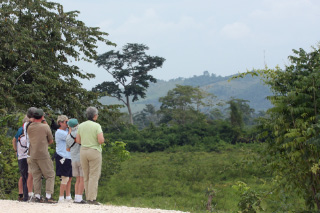
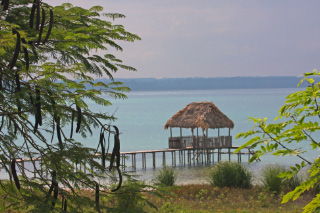
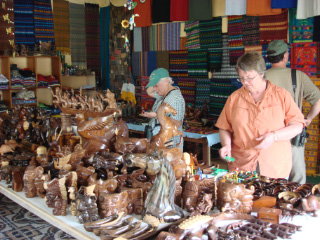
The Guatemalan country side is quite different from much of Belize. The rolling hills are similar to the Belize side near San Ignacio, but the forests have been cleared and only remnant secondary forest and wooded edges of fields are attractive for birding. The Vuelta Grande marsh at lunch time was good birding, however, and gave us most of the expected waders.
Fortunately we only have another two miles of bad road and then we are on potholed pavement, a vast improvement. We take another break when we reach El Remate, an artisan area along pretty Lago Petén Itzá. Lots of gift shops with local crafts keep the shoppers happy and Chris and I spend our time birding, finding a flock of Laughing Gulls and a few Royal Terns at this far inland lake.
(Shari) They finally catch up and we pull out to our next stop: shops. I hop out with hope in my heart for a good bargain, but find things too expensive for me. Some people get some really nice things, but I pass on the opportunity for now. At the gates to Tikal, we give the guard our border information sheet and I actually understand the Spanish he asks us: how many days, how many people, and he tells us where to go for camping and how much to pay. We tell him we have six more units coming in about 30 min. Our birding guide is waiting for us when we arrive and he tells us where to park and explains the procedures for tomorrow. Bert gets set up while I arrange a group LEO and use of the swimming pool at the Tikal Inn. At 5 PM, the margarita maker is busy churning away and we sit outside waiting for our social to start. I think we all are exhausted. Later we walk 50 ft. to the nearest restaurant and join Chris and May for chicken dinner.
(Bert) Our first group arrives at Tikal and most take off quickly for birding while I take care of errands. At tonight’s count-off we tabulate another 100+ species day.
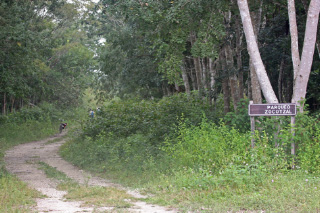
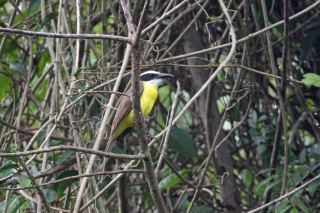
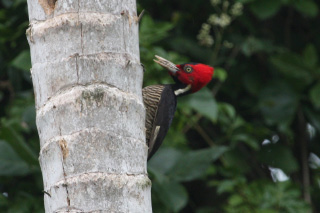
(Shari) First the light goes on. Then the RV shakes. Then something moves my bed-once, twice, three times. What in the world is Bert doing? He tells me his battery on the computer has run out and the cord from the cigarette lighter does not reach the dinette. Hence he is sitting on the floor, writing journals. I look at the clock and wonder if 15 min. is enough time to get ready to join the group for the 6:15 outing. I do make it but barely. I think the group is surprised that I am joining them and it looks like only Arleen is feeling poorly today. She is still battling the bronchitis she had at the beginning of January. I have high hopes of seeing the squirrel pheasant - a bird that has eluded Judy for all the years she has traveled with us. The morning sky is overcast and not much light shows through the jungle. May reads my lips as I tell Ralph this is boring and shakes her finger at me. I know the group is getting an impressive list of birds, but many are heard only. I don’t find that satisfying. I want to see a flashy-colored bird that I will remember for years. I do see a Masked Tityra, a gray-headed fly-catcher, oscillated turkeys and some other birds that I forgot the name. I hear the familiar click of the Red-capped Manakin but the jungle is too dark and I am too impatient to stick around to see it. The highlight of the trip was seeing the really red ears and yellowish back of a coati as it crosses the path behind us. After three hours we head back and when we see the parking lot I take off like a horse smelling the barn. I am hot, hungry and exhausted. My knee is throbbing, (I have a big bruise and I think it happened when Bert banged me with the stepstool a few days ago) and I intend to take a nap and finish paperwork this afternoon.
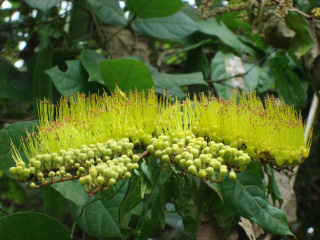 (Bert) We meet our guide Luis at 6:15 AM and head down the old airport
runway, our main target being Pheasant Cuckoo, the one and perhaps only Tikal
species that no one in our group has seen. The first good bird of the morning
surprises Luis and he stumbles for its name, since he has rarely seen it at
Tikal. I call Rose-throated Tanager and other birders quickly gather around us
to try to see the female tanager in the dense scrub. A few see it before it
hides again. Such is the story of most of the birds we find this languid and
darkly overcast morning. The birds sing and call profusely, yet do not come out
of hiding. A few dozen feet from the tanager Chris hears a Gray-throated Chat
and again only a few get a glimpse. One that never comes out of hiding is
White-browed Wren, a variety of Carolina Wren. Although it sings continuously,
even the inducement of a recording will not get the wren to move from its hiding
place more than 30 ft. into the brush. Shari, who surprisingly accompanied
us on this early morning birding hike, is unimpressed with birding. She perks
up, however, when we see a small flock of Gray-headed Tanagers feeding on
Curassow Crest (which Luis calls by its Spanish name peyne de miko). Even though
the tanagers are hard to see through the brambles, Shari gets a good look and
tells me this bird is worthy of going on her life list, a somewhat whimsically
selective list of birds that I keep on my computer software for her. So what
happened to the Pheasant Cuckoo? We tried a dozen times with a recording to
attract the cuckoo. Twice Luis and I and a few others heard a distant cuckoo – a
“half-lifer” for me – but nothing better.
(Bert) We meet our guide Luis at 6:15 AM and head down the old airport
runway, our main target being Pheasant Cuckoo, the one and perhaps only Tikal
species that no one in our group has seen. The first good bird of the morning
surprises Luis and he stumbles for its name, since he has rarely seen it at
Tikal. I call Rose-throated Tanager and other birders quickly gather around us
to try to see the female tanager in the dense scrub. A few see it before it
hides again. Such is the story of most of the birds we find this languid and
darkly overcast morning. The birds sing and call profusely, yet do not come out
of hiding. A few dozen feet from the tanager Chris hears a Gray-throated Chat
and again only a few get a glimpse. One that never comes out of hiding is
White-browed Wren, a variety of Carolina Wren. Although it sings continuously,
even the inducement of a recording will not get the wren to move from its hiding
place more than 30 ft. into the brush. Shari, who surprisingly accompanied
us on this early morning birding hike, is unimpressed with birding. She perks
up, however, when we see a small flock of Gray-headed Tanagers feeding on
Curassow Crest (which Luis calls by its Spanish name peyne de miko). Even though
the tanagers are hard to see through the brambles, Shari gets a good look and
tells me this bird is worthy of going on her life list, a somewhat whimsically
selective list of birds that I keep on my computer software for her. So what
happened to the Pheasant Cuckoo? We tried a dozen times with a recording to
attract the cuckoo. Twice Luis and I and a few others heard a distant cuckoo – a
“half-lifer” for me – but nothing better.
After a long midday break we resume birding at 4 PM, this time entering the
Tikal ruins. We encounter an ant swarm that Mark and Joanie found earlier,
attended by a Northern Barred-Woodcreeper. The ant swarm leaves the woods and
crosses the gravel entrance road. First the ants spread out and canvas the whole
road, each ant on its own, but finding no plant life to consume, their pattern
changes to long lines of two to three ants abreast. Some communication must be
going on and in a few minutes the columns of ants all reverse direction and
converge at a spot in the center of the road. Now they mass in a dense grouping
of thousands. After a minute of convention, a new strategy resolved, the ants
march off in mass directly across the road.
Birding is much better this afternoon, with many highlights. I am delighted
to get a good photo of an Yellow-olive Flycatcher, not an easy bird to get out of
the dark shadows. We make numerous attempts at seeing a Tody Motmot at Complex
Q, behind aritorio, and again at Complex R, but have to settle with
“heard-only”. At Temple IV, Luis leads us to a Mottled Owl
which he found a few
weeks ago nesting nearby. On the opposite side of the temple Luis finds us a
Rufous Mourner and a very cooperative one at that, allowing me to take many
photos
. We climb the steps up to the top of Temple IV, a much easier climb then
when I did it last on steep ladders and Mark and Joanie make the same comment
since they visited Tikal many years ago.
 The sunset view is exquisite, highlighting the temples that protrude above
the canopy. Brown Jays, Mealy Parrots and Keel-billed Toucans wing above the
canopy and the best is an Orange-breasted Falcon in flight. Descending the
staircase and walking the trail, darkness is closing in and we can barely see
the pair of Great Curassows
The sunset view is exquisite, highlighting the temples that protrude above
the canopy. Brown Jays, Mealy Parrots and Keel-billed Toucans wing above the
canopy and the best is an Orange-breasted Falcon in flight. Descending the
staircase and walking the trail, darkness is closing in and we can barely see
the pair of Great Curassows that prowl a grassy edge of the forest. We hear a
pair of Barred Forest-Falcons serenading nightfall and we have the good fortune
of seeing one of them.
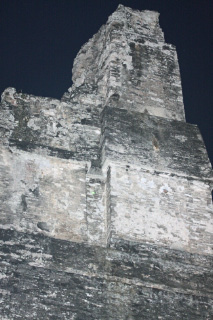 When we reach Acropolis Central we see one of the
Orange-breasted Falcons fly to Temple I and disappear into a hole in the
stonework. Now it is almost pitch black in the forest and we use our flashlights
to navigate, finding spider monkeys with my torchlight, some scrabbling coatis
and a jumping spider. When we near the cenote near the vendor booths, we hear
the chorus of Bufo marinus
When we reach Acropolis Central we see one of the
Orange-breasted Falcons fly to Temple I and disappear into a hole in the
stonework. Now it is almost pitch black in the forest and we use our flashlights
to navigate, finding spider monkeys with my torchlight, some scrabbling coatis
and a jumping spider. When we near the cenote near the vendor booths, we hear
the chorus of Bufo marinus and see two of the giant toads close up with our
lights. Exhausted from a day of hiking and birding, when we separate no one
wants a 6 AM start tomorrow. I meet Shari and with Bob and Arlene, Mike and Kay,
we go to Jaguar Inn for dinner. It is late when we finish and I hear a Mottled
Owl hooting from the tall trees above us as we walk the short distance to our
camping area and a welcome good night’s sleep.
(Shari) After Bert leaves for the afternoon bird tour, I walk to the Tikal Inn to give them our lunch order. I fill my “Maytag” with water at the restroom and lug it back to the RV, putting in some soap and dirty clothes. Sitting outside in late afternoon, Bob, Arleen and I discuss the next travel day. We join Mike, Kay, Arleen and Bob for dinner at the Jaguar Inn. As we walk the three short blocks, I am reminded of our last trip to Tikal and how pitch black the night was. Tonight we have flashlights and as we walk home I still am confused with directions. I am using the red light on my headlamp and Mike quips that maybe I should not use my taillights to navigate. He is just so funny. Bert says I should try not walking in reverse.
(Bert) We try the airport runway again, seeking the Pheasant Cuckoo to no avail. When we reach the Mirador four of us – Joanie, Tom, Clay and I – climb the steep wooden steps of the treehouse structure to the platform above the canopy. I don’t remember the platform being this slanted since the last time I did this, giving me the feeling it and the tree will topple with our weight. Our view is across Tikal, with four temples rising above the continuous green canopy. We can see feeding Keel-billed Toucans in the treetops and flying above the canopy is a Gray-headed Kite. We follow its movement until it disappears behind a higher branch and then see a perched raptor that is probably an immature Hook-billed Kite. I photograph it so that I can use the computer to lighten the features darkened by the backlit bird and confirm its identity.
After checking out Aguada Dimick, I start returning toward camp when Nelda
calls me back to a bird Mark found. When Marks says he thinks it is a
Grasshopper Sparrow, I tell him the habitat is completely wrong and I don’t
think it occurs here. But he describes a bird that doesn’t seem to fit other
possibilities. Searching again, we relocate the bird and I think he may be
right. Immediately I start taking lots of photos and fortunately the sparrow
jumps into the open only a few feet in front of me. The photos
validate our ID
and a later examination of bird resources shows no mention of Grasshopper
Sparrow in the two books identically titled The Birds of Tikal (Smithe & Trimm,
1966) and (Beavers, 1992). However, in Annotated Checklist of the Birds of
Guatemala, Eisermann and Avendaño (2007) mentions three locations where
Grasshopper Sparrow was reported 1999-2002 in Guatemala, but not Tikal.
Near the start of the airport runway trail I see Nelda intently watching
something on the lawn. As I get closer I see it is a Gray Fox tame enough for
many photos. Back at camp Judy wants to tell me about her experiences birding
solo this morning. While sitting quietly in the woods a Margay walked right up
to her. Judy’s birding strategy certainly attracts mammals, for her list of
closely approached animals is impressive and unsurpassed by any of the rest of
us. She anxiously tells me of a Cinnamon Woodpecker she is convinced she saw
there also. Since she birds alone and doesn’t carry a camera, I am suspicious of extralimital sightings and this particular bird is known only as far north as
Panama and Costa Rica. We discuss the more expected alternative,
Chestnut-colored Woodpecker, but she insists the back and head were identically
colored. Unfortunately, she did not observe the breast and tail. To be sure, I
hike to the location she pointed out on the Tikal map and when I arrive I play a
recording of Chestnut-colored. Immediately I hear a response and the woodpecker
swoops below the canopy and alights on the truck of one of the giant trees. It
looks like Chestnut-colored to me and my photos later confirm that.
At tonight’s count-off of the birds we tabulate all of those seen at Tikal and end with a total of 149 bird species, plus 8 mammal species.
(Shari) I just love days like today. I can do things on my own leisurely schedule. Bert gets up for birding and fills a bucket with rinse water so that I can move the soapy wash into it. When I get up, that is my first task: using the wringer to get out the water. A busload of German tourists sees me wringing and point thumbs up and say how wonderful. They are old enough to remember wringers too. By 9 AM the wash is all neatly hung on the line - my mother would be proud that all the socks are aligned together, etc. I read a bit before our scheduled lunch. I think everyone enjoys the ambience and the meal at Tikal Inn. Clay gets a shock when he reads his bill though. It says over 700 quetzals. Even with a good exchange rate, that comes to about $100. He then realizes that people here often write their ones like sevens and his bill is barely above $20.
Judy visits us this afternoon and she and Bert discuss her sightings. She is such a good sport when he does not believe her and tonight he even makes a story of her sightings as a lesson in how to and how not to be sure of your bird. She and Bert go off to the vendor area to shop and they leave me behind. It is too hot and too far to walk with my bad knee to go shopping. I think I will have other opportunities down the road. We have a short social before a bird count. The list is enormous and Bert tells us it is 149 species. Dorothy surprises us with homemade banana bread and warm cheese sauce for nachos. Thanking Dorothy for the surprise, I also thank Ralph for his valiant help with sewer dumping in the muddy San Ignacio camp a couple of days ago and I am glad to hear his shoulder is better. Bert goes off with Joanie and Mark for a swim at the hotel pool while I write this journal. I think Bert is in seventh heaven. He gets to do what he loves best, to bird, and then to bird with all these great birders. It is a fun group and Lee quips, tongue in cheek, that in his day, birders were more serious. In all the trips I have taken with him, I don’t know if he has ever been serious.
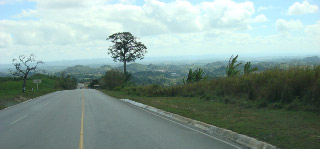
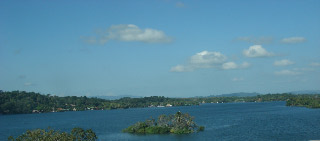
(Bert) Leaving Tikal, we head south on good highways to Rio Dulce. We stop once to refuel and I buy regular gasoline at US$4.08 per gallon (in Mexico it was $2.74 and in Belize it was so expensive we didn’t buy any).
The road gradually rises in elevation until by lunch time we are at 1700 ft. Our stop at Finca Ixobel is about 25 mi. north of the latitude of Punta Gorda in Belize and the habitat of scattered Caribbean (Honduras) Pine is similar to Mountain Pine Ridge. In fact, this is probably the same Maya Mountains that dominate southern Belize. We find Azure-crowned Hummingbird, both Yellow-throated and Grace’s warblers, and doves we think are Plain-breasted Ground-Doves, but will look at the photos to verify.
(Shari) The drive today is lovely. Guatemala is much cleaner than Mexico. The rolling hills and green landscape induces me to take picture after picture. The road is very smooth, if curvy, and driving is a breeze. We arrive at our lunch destination by 10:30. Two and a half hours later we depart with full tummies, more trip birds and completed Internet sessions. Bert has a huge hamburger with fries and I have a chicken sandwich with avocado. Both are on homemade rolls and bread. I had everyone sign up for bread while we were in San Ignacio and e-mailed the order days ago. Our order was ready, packed in bags with individual names on each bag. I bought a loaf of whole wheat bread, a loaf of garlic bread, a loaf of strawberry bread and four cinnamon rolls. I had a hard time fitting it into the freezer but I did it. It seems everyone enjoys their lunch but it makes Bert and me very drowsy on the rest of our drive. I tell him that if he a good driver I would not have to lean when we take a curve. Lee says I should strap my seatbelt tighter.
We arrive at our campsite and are met by Roberto. Lester, the Wagonmaster for the first (leading) Panama caravan had alerted him to our arrival. He only speaks Spanish and knows NO English so negotiations for our boat trip tomorrow - time, amount, where, etc. - must be done in Spanish. He helps with our check in and shows us where to park. I want to be sure of his directions so I ask where each rig should park, counting them off one by one and even asking which direction they should park. I have a bit of trouble with that one and resort to using my whole body - backing up to indicate “Should we back in?” or going forward to indicate “Should we go forward and park parallel to the boat storage”. Finally after I count to 12, I say “Es todos” and wipe my forehead. The two men just have to laugh out loud at my antics. Roberto takes me to reception and again I must deal in Spanish. Later Judy wants her rig washed and Bert calls me over to ask if it is okay to park by the water spigot all day long while we are going on our boat trip. After I accomplish that task, I say “How do you like that Spanish?” I get a water bottle out of the fridge and sit on my steps in the shade to relax before a swim in the beautiful pool. Joanie, Mark, Lee, Pat, Bert are already there and later John, Nelda, Gilford and Charlu join the gang. I retreat to the rig to do paperwork and eat a salad before bed.
(Bert) The two boats await us at the dock and soon we head toward the high
arched bridge – longest in Central America – stopping short at an island of a
1000+ Neotropic Cormorants. A Great Egret flies with a branch crossed in its
bill, shifts its feet forward and wings backward and gently lands atop the tree,
joining its mate at the nest. Attractive greenish lores at its bright yellow
bill and lace-like finery of splayed feathers illustrate the egrets at the
height of breeding season. Crossing under the bridge and cruising along the
lake, we see attractive wooden pole houses with steep thatched roofs fronted by
wooden crisscross railings and piers. Expensive powerboats, small yachts and
sailing ships moor nearby. The whole scene is like a movie script, magically
unreal in its tropical beauty. After passing the historic fort, we turn about
and head back toward the bridge, stopping briefly at a mangrove patch. Earlier
at camp a Ferruginous Pygmy-Owl called incessantly. Now from the boat I hear a
distant Central American Pygmy-Owl calling with shorter bursts of staccato
whistles. We continue across a broad lake surrounded by lowland broadleaf
forests with most of the shoreline edged in small dwellings, combining the rich
and the poor.
Stopping at an island refuge, we scan the birdlife when Chris reports “Mangrove Cuckoo” and binoculars from both boats focus on the perched bird. It stays just long enough for me to get a few hurried photos. Back toward the southern shoreline, our driver Roberto angles the boat toward a narrow passageway where the houses and boats display signs and names that indicate Texans, Floridians and Hawaiians live here. We enter a mangrove swamp with a narrow inlet sometimes just wide enough for the boat while branches scrape across the boat canopy. He cuts the engine and we glide silently, no one speaking as we absorb the stillness of the swamp and slowly the sounds of nature return. In the shadows beneath the extending mangrove branches a Sungrebe lurks. Disturbed, it tries to evade our stares and it swims toward the other boat. I alert them on the radio and they all see the prize bird too. We see only a few birds, such as the winter-plumaged Chestnut-sided Warblers that spring through the leaves like gnatcatchers, but we hear many. Northern Bentbill and Thrush-like Schiffornis call, and the best is a Western Slaty-Antshrike.
Back in the main channel, Roberto speeds the boat for a half hour. Flocks of Brown Pelicans and Neotropic Cormorants ride the air currents above the river, the pelicans keeping pace with us, the cormorants surpassing. We stop again, this time to watch a Purple Gallinule and Common Moorhens brightly illuminated in morning sun as they feed across a lily pad inlet.
Now the channel narrows into a river and the sides form mountains with primary forest (or dense secondary forest) to the north and less dense more inhabited forest to the south. Perched White Hawks are conspicuous like golf balls on a putting green. Common Black-Hawks glide against the steep mountainsides, coming to rest on protruding branch limbs. High above them fly White-collared Swifts.
We reach Livingston at the Caribbean Sea and visit the colorful city, dine on lobster, check the shops – stories I’m sure Shari will write about.
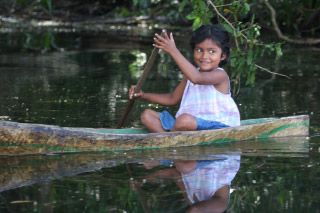
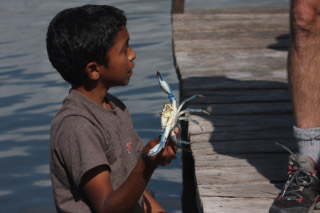
(Shari) Did you ever take a boat ride in Wisconsin Dells, seeing tall cliffs on either side of you? Our boat trip today reminded me a little bit of that but better, much much better. We met Roberto in front of the hotel at the boat dock. Half of us, determined by the pick of a red or black playing card, got into Astrid and half of us got into Marjorie. The coolness of the morning feels good on my skin but many have to wrap up in a jacket. Our first stop gives us a close-up look of an egret in breeding plumage, complete with its bright green cheeks. I notice the palatial houses with thatched roofs built along the shore of the river with yachts moored under canopies in the front yard and swings on the decks surrounding the houses. This area has lots of money and many boats go up and down the river taking people to the mouth of the Caribbean and the quaint town of Livingston. I see a group of children on the dock all dressed in their school uniforms waiting for the “school boat” to pick them up. I see solitary men sitting low in dugout canoes fishing with a single line or a net. I see boats full of tourists going back and forth. Bert sees birds. Birds along the cliffs, birds in the mangroves, and birds in the water. Dorothy finds a sungrebe for the group. Our rest stop is a quaint store with a darling family. A baby no more than four months sleeps peacefully wrapped in a colored cloth swinging in a hammock. An older boy catches a crab and sells it to May. Later I see he has caught a fish and is trying to sell it to another group of tourists. We taste homemade empanadas filled with cooked cabbage, onions and carrots. Clay says it reminds him of something he ate as a kid instead of bread. The lone “potty” is set back along a wooden walkway in the trees. No running water, it is flushed with a hand pan filled from a bucket.

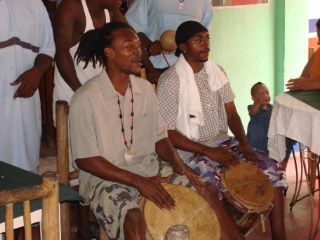

Arriving in Livingston around noon we head for restaurants. Bert and I choose the Happy Fish restaurant and order lobster. The whole lobster takes up the plate and vegetables, rice and/or potatoes completes the meal. The town is full of tourists, quaint shops and neat looking restaurants. Built on a hill, it overlooks the sea and I wish we had more time to shop and browse. Bert buys two T-shirts which he does not need and I buy a table covering which I do not need. Some of us buy bowls made of banana leaves. I intend to use mine as a fruit bowl. All too soon we have to return to our boats and the cool drive home. We meet around the pool for a travel meeting and bird count off. It has been a very special day for me and has given me another glimpse of the beauty of Guatemala.
(Shari) Again I say Guatemala is just beautiful. Today we drive great roads through the mountains. Flowering trees adorn the roadsides with bright yellows, purples, blues, pinks and reds. The red tree is in the process of dropping its petals and the roads are covered as if the towns are laying out a red carpet for us. Arlene had mentioned a side trip at the travel meeting and our group takes the excellently paved road to the Maya ruins. On the way, we pass through the Dole Banana plantation and are stopped by a gate. Soon bunches of bananas, hung from a conveyor cable, cross the road on their way to the processing plant. The gate opens and we continue to the end of the road. Although small, the ruins have remarkably preserved stelae, manicured grounds and a small grouping of vendor booths with unique things that many buy. Carol tells me of the jade museum that I wish I had time to visit but we have spent over 90 min. already at this rest stop. Our next rest stop, less than an hour away, is a place to buy smoothies. I order a strawberry smoothie before I realize that I never eat strawberries south of the U.S. border for fear of getting sick. Oh, well! I take a stint at driving since the roads have been so good so far and not different than a rural road in the U.S. We arrive in the early afternoon at our hotel parking lot and spend the next two hours looking for the dump. Apparently the new manager does not know its location. From what Arlene has told me, I think I know where it is and get the manager to look. I do not want to dump unless I have his permission in case I am wrong. He agrees that it must be the dump and soon Arlene and Bob arrive to confirm it. Bert goes birding while I join Pat and Charlu in the huge clean pool before I take a shower. Later we meet eight others from our group for a tasty dinner in the hotel dining room.

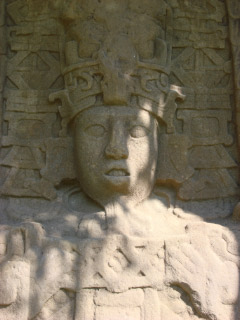 (Bert) Guatemala highways today are good to excellent, wide with center and
side striping, paved shoulders, unbroken asphalt and generally comparable to
state highways in the U.S. Passing lanes on steep hills speed traffic past slow
trucks, a feature standard in the U.S., yet almost unknown in Mexico. Flowering
trees, especially pink gledecea (spelling?) border the roads, often arching
above us to form a nearly closed canopy. Winding up and down mountains,
expansive views of the countryside delight us. On the one hand I imagine what
this might have looked like when vast broadleaf forests covered the land and
must have teemed with wildlife. Yet, just as we cleared the eastern hardwood
forests of the U.S. in the 1800s, so this land has been cleared. On the other
hand, what we view now is vibrantly green fallow fields, cultivated crops such
as corn, and untilled scrub, mostly edged in living fence rows – stout straight
branches stuck into the ground that sprout roots and leaves and become a tight
line of trees connected by barbed wire – and scattered, tall, secondary growth
trees. The overall effect paints a beautiful pastoral scene of rolling
countryside.
(Bert) Guatemala highways today are good to excellent, wide with center and
side striping, paved shoulders, unbroken asphalt and generally comparable to
state highways in the U.S. Passing lanes on steep hills speed traffic past slow
trucks, a feature standard in the U.S., yet almost unknown in Mexico. Flowering
trees, especially pink gledecea (spelling?) border the roads, often arching
above us to form a nearly closed canopy. Winding up and down mountains,
expansive views of the countryside delight us. On the one hand I imagine what
this might have looked like when vast broadleaf forests covered the land and
must have teemed with wildlife. Yet, just as we cleared the eastern hardwood
forests of the U.S. in the 1800s, so this land has been cleared. On the other
hand, what we view now is vibrantly green fallow fields, cultivated crops such
as corn, and untilled scrub, mostly edged in living fence rows – stout straight
branches stuck into the ground that sprout roots and leaves and become a tight
line of trees connected by barbed wire – and scattered, tall, secondary growth
trees. The overall effect paints a beautiful pastoral scene of rolling
countryside.
We stop for an hour or so at a Maya site that features huge stelae still erect and ornately carved with cartouche and the shapes of historic rulers, probably the best collection I have seen still at their original site, since most now have been relegated to remote museums. The birdlife around in the surrounding forest is a wide variety of wintering warblers, including Blue-winged and Golden-winged in adjacent trees. The prize find, though, is a pair of Turquoise-browed Motmots.
As we climb in elevation, the land is more arid, greens shade to browns and the mountains look ragged and raw, yet appealing. The climb becomes steep and the engine downshifts to make the grade. Forests close in on us and pines become more prevalent. An azure blue bird flies across the road, much like a Yucatan Jay but since that does not occur here it must be another jay. When we arrive at the hotel parking lot in Esquipulas and I am attending to directing others to parking spots, I hear Mark and Joanie on the radio talking about the jays they see on the hillside – Brushy-crested Jays, a species endemic to a small area of Guatemala, Honduras and Nicaragua, and a life bird for everyone that has the fortune to see it. Later, we hike up the steep country road behind the hotel. After over an hour of seeing few birds – we do see Rufous-naped Wren and Spot-breasted Orioles, though – I return to the hotel with Judy. Others later report they found the jays as well as heard a Plain Wren singing. Before dinner at the hotel, I swim a quarter mile in the long lane-marked swimming pool, the water a bit chilly here in the mountains and the air lower in oxygen so I have to take breaths more often.